Surprises come thick and fast in this remote, fragile land
By Andrew Conway
It’s more of a plea than a question. “We will see a polar bear, right?” I ask veteran naturalist Dr John Kirkwood on the first night of our Arctic expedition. He rolls his eyes, as if he’s heard the question a thousand times before, and replies gently: “There are other animals in the Arctic besides polar bears.”
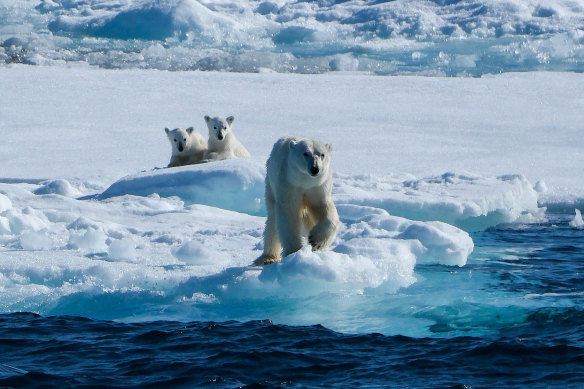
A female polar bear and cubs on the ice.Credit: Michael Hirsch
Trust me, he’s a man of his word. By the end of day two, we’ve seen reindeer, ringed seals, walruses hauled out on beaches and close to our Zodiacs, pods of humpback and milky-white beluga whales, as well as a rare blue whale which swims calmly around our ship for more than 30 awe-inspiring minutes.
Day three delivers a family of Arctic foxes, an adult female and three adorable kits, entirely unperturbed by the bank of camera lenses trained on their playful antics. Later that afternoon we spot a bearded seal snoozing on sea ice and more humpback whales, surfacing and diving in perfect unison in iceberg-strewn waters.
As our voyage continues, Dr Kirkwood’s “Sightings List” fills with mammals, not to mention 28 Arctic bird species: northern fulmars, ivory and glaucous gulls, skuas, pink-footed and barnacle geese, kittiwakes, Atlantic puffins and ubiquitous Brunnich’s guillemots among them.
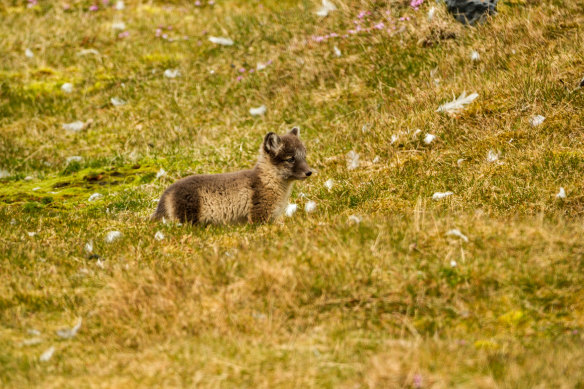
An Arctic fox in the field.Credit: Michael Hirsch
Did someone mention polar bears? It takes five days for the first one to appear on the horizon, a distant but clearly visible adult male traversing an ice sheet, but he’s merely the advance guard to a plethora of them.
During the next eight heady days, we’re treated to six spectacular sightings of the Arctic’s apex predator: a fully grown male dragging a dead walrus calf onto an ice floe, shredding the skin with its teeth and ripping into the blubber; an adult female giving her two cubs a crucial lesson in survival, stomping the ice in classic hunting mode and making the young cubs jump between floating sea ice; a lone adult male feasting on a ringed seal, blood staining the snow and the bear’s thick fur.
These extraordinary, up-close wildlife encounters are among dozens I’m privileged to witness on a 15-day voyage on board the Sylvia Earle, a small expedition ship operated by Australia’s Aurora Expeditions.
This particular sailing is a first for the company – an in-depth exploration of Svalbard, some 1050 kilometres from the North Pole and the most northerly archipelago in the Norwegian Arctic – featuring a successful circumnavigation of Spitsbergen, the largest island, and venturing to remote places where few have been.
I’m in safe hands: Aurora is a 32-year pioneer of expedition travel. The ship, launched in December 2022, is purpose-built for polar (and warmer waters) exploration with world-class technology and environmental credentials, and the voyage is being guided by a 15-strong expedition team of Arctic experts with a third-generation Ukrainian captain at the helm.
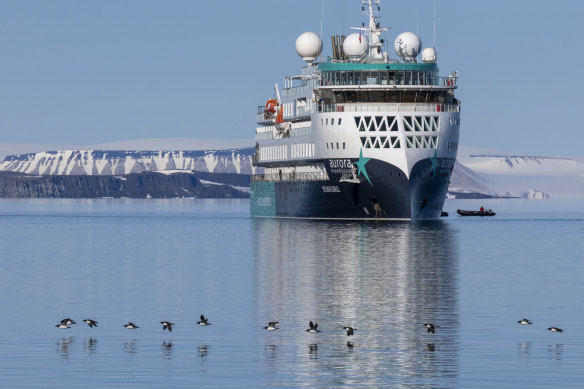
The Sylvia Earle in the Arctic.Credit: Scott Portelli
All the same, expectations are running high as I and 83 fellow expeditioners from Australia and 12 other nations board the ship on a late-June afternoon in Longyearbyen, the capital of Svalbard and the gateway to this remarkable wilderness region.
After mandatory and detailed safety, environmental, biosecurity and conservation briefings on the first evening, we understand the two central tenets of an Aurora voyage. We are on a polar expedition, not a cruise, and we should expect the unexpected.
Both are immediately apparent when expedition leader Howard Whelan, a veteran of 30 Arctic expeditions and more than 100 in Antarctica, announces that heavy sea ice to the north of Svalbard and unpredictable fog elsewhere requires a major change of itinerary. Instead of navigating clockwise around Spitsbergen, he opts to travel anti-clockwise in the hope the conditions improve as we sail.
That key decision, an early glimpse of Whelan’s meticulous communications with Captain Arsen Prostov and his own expedition team, sets the ship on a revised but carefully considered course that puts us in pole position for an astonishing Arctic experience.
Thick fog and low cloud quickly turn to sparkling blue-sky days as we venture south along the jagged mountains of Spitsbergen’s west coast, north-east into the polar desert of Edgeoya and Barentsoya islands, and then as far east as we can sail past the colossal frozen ice caps of Nordaustlandet – a known polar bear migration route – before heading up Hinlopen Strait and into the spectacular northern fjords.
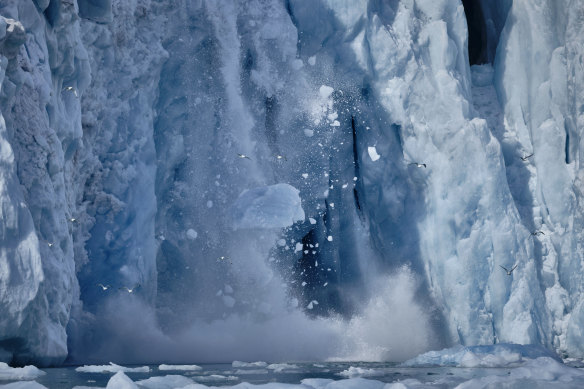
A glacier calving ice in Svalbard.Credit: Peter Eastway
Ancient coastlines deliver tongue-twisting Nordic names – Alkefjellet, Torellneset, Brasvellbreen and Alkhornet-Trygghamna among them – each peppered with compelling geological, historical and cultural heritage sites that are the stuff of Arctic folklore.
What appears from a distance to be desolate, inhospitable landscapes suddenly morph into dynamic environments as we tour by water in a fleet of Jacques Cousteau-designed Zodiacs, paddle by sea-kayak or hike on shore, all in the company of our ever-vigilant expedition team which scouts each new site carefully before we land.
There are potential dangers afoot. The guides carry rifles and flares in case of polar bear encounters and there are strict rules to follow: stay in our walking groups, do not stray or lag behind, and follow guides’ instructions at all times. Although polar bears will usually try to avoid human contact, they remain the Arctic’s supreme predators and the expedition’s rules are in place to protect them as much as us.
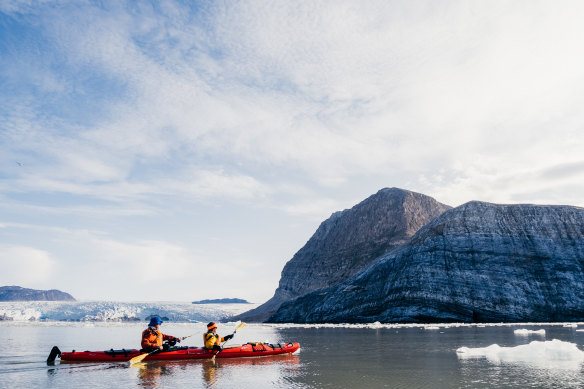
Exploring by kayak.Credit: Matt Horspool
Surprises come thick and fast on more than 20 morning and afternoon excursions. Vast glacier-fronts calve with a thunderous rumble or sudden whip crack; “growler” icebergs and brash ice melt with an eerie snap, crackle and pop; monumental cliffs and waterfalls teem with birdlife and tundra wildflowers abound.
We visit historic trappers’ huts, inspect remnants of long-abandoned traps, and fall silent at unmarked wooden crosses and stone graves which speak to the Arctic’s darker human past when polar bears, foxes and many thousands of whales were hunted mercilessly, some whale species to extinction.
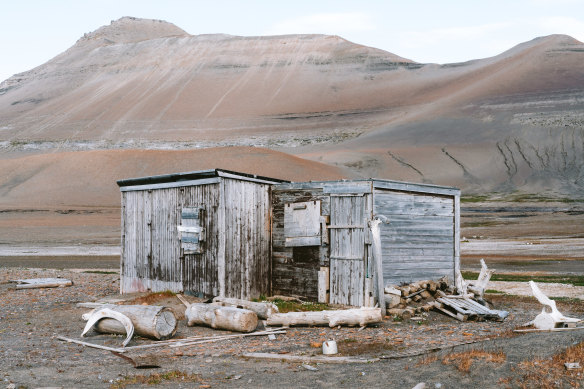
An abandoned trapper’s hut at Diskobukta, Svalbard.Credit: James Popsys
Our voyage is a wildlife hunt with conservation front and centre, a shared experience with expeditioners and crew lining the ship’s observation decks and scanning land and sea with high-powered binoculars and cameras to capture every whale fluke, walrus whisker and polar bear breath.
The otherworldly, frozen-in-time landscapes appear even more surreal bathed in 24-hour daylight, a body clock-altering summer phenomenon when the so-called Midnight Sun never sets.
Named after Dr Sylvia Earle, the world’s foremost marine scientist and advocate of ocean conservation, the ship accommodates up to 132 like-minded expeditioners in contemporary comfort. The staterooms and suites, many with balconies, are thoughtfully designed with generous storage space for extended sailings and ensuites with underfloor heating.
A sister ship to the slightly smaller Greg Mortimer, launched in 2019, the Sylvia Earle features two restaurants and bars, a lecture theatre where the expedition team delivers engaging presentations, a heated outdoor pool and two hot tubs for relaxing between excursions. The onboard atmosphere is relaxed, informal and egalitarian.
The eight decks are named after leading female conservationists around the world, part of Aurora’s “Women in Conservation” program, and expeditioners are encouraged to participate in Citizen Science projects on deck, on shore and in the ship’s dedicated Science Centre.
Beach clean-ups in various locations attest to Aurora’s ongoing commitment to conservation. On one beach at Eolusneset, we collect up to 100 kilograms of washed-up plastic pollution, a grim reminder of humanity’s disregard for marine environments.
The Arctic, however, is under far greater threat from global warming. It is currently the fastest-warming region of the planet, parts of it increasing by 5 degrees Celsius since 1980. During our visit, one day tops 21 degrees, 11 above the summer average, and the effects are plain to see.
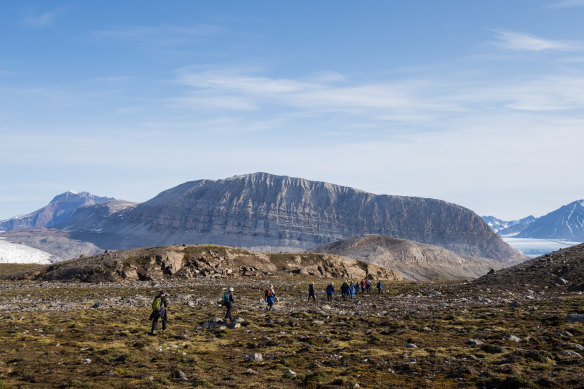
Expeditioners on foot.
Once-frozen ice caps gush with waterfalls, glaciers are receding rapidly and sea ice is melting at an alarming rate, with scientists predicting the Arctic may be devoid of summer sea ice as early as 2050.
Aside from the Arctic’s critical cooling effect on the planet, its sea ice supports an entire ecosystem of marine life. Seals mate and reproduce on it and polar bears use it as a platform for migrating, mating and feeding on seals. Without sea ice they will not survive, an unthinkable scenario.
Despite the ship’s minimal environmental footprint, I can’t help but think we’re part of the problem being here, but the expedition’s major focus on education and conservation is commendable. As Dr Earle says: “You can’t protect what you don’t know.”
On our final day, we alight at Alkhornet-Trygghamna, a windswept coast dotted with reindeer and dominated by a rocky mountain swarming with birdlife. This is prime Arctic fox territory and they don’t disappoint.
As if on cue, an adult male, female and three kits appear on a patch of snow, skidding on the ice and rolling over each other, seemingly without a care. It’s a joyous farewell to a polar wilderness under intense pressure but delivering nature in its rarest form – at least for now.
THE DETAILS
FLY
Fly to London with Qantas (qantas.com) and connect to Longyearbyen, via Oslo, with SAS (flysas.com).
CRUISE
The 15-day, 14-night Svalbard in Depth voyage on board the Sylvia Earle departs Longyearbyen on June 10. Prices from $24,115 a person for a balcony stateroom, including all meals and a hotel room the night before sailing. Optional sea-kayaking activity program from $1650 a person. Other Arctic expeditions also available. See auroraexpeditions.com.au
MORE
The writer travelled as a guest of Aurora Expeditions.
Sign up for the Traveller Deals newsletter
Get exclusive travel deals delivered straight to your inbox. Sign up now.